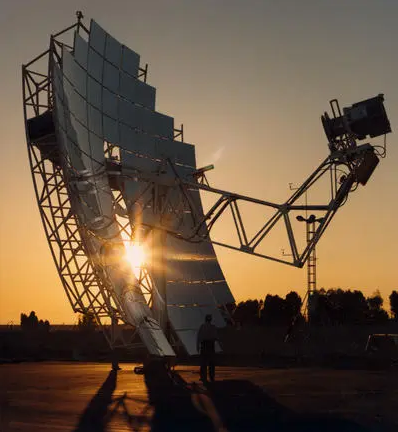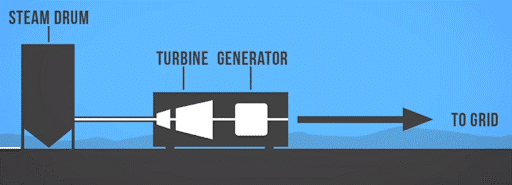Solar Thermal Power Plant: Advantages and Disadvantages
If you want to know the benefits and drawbacks of solar thermal power plants, you’ve come to the right place.

Heating water in your house through solar thermal energy is one of the best ways to save up on energy costs. On an industrial scale, it’s possible to harness heat from the sun to produce electricity for an entire areal population. This is a Solar Thermal Energy System.
As a solar streetlight manufacturer, we place a high value on all sorts of renewable energy solutions. Solar Thermal Heating is one of our major lookouts for the future.
Why? Not only can solar thermal systems provide lots of benefits for our environment, but it can also save millions on utility costs. Today, there are over 54 operational solar thermal power stations and counting around the world. So together, let’s help governments in increasing this number.
In this article, you’ll find how important and easy it is to operate a solar thermal power plant.
What is a Solar Thermal Power Plant?

A Solar Thermal Power Plant is a large facility for energy generation that uses the sun’s energy to produce electricity. The electricity is then transferred to the grid for consumption in homes, buildings, factories, and other facilities.
Let’s understand how it works before we jump into enumerating its pros and cons.
How It’s Different from Other Traditional Power Plants
There’s not much of a change from the way coal fired power plants and hydroelectric plants produce electricity. In these traditional power generation plants, you simply need to generate steam to power a turbine. The turbine is then coupled to a generator that functions to transform mechanical energy to electrical energy.

In coal-fired plants however, you need to burn coal to collect steam. On the other hand, solar thermal power systems use the collected sun’s energy to boil a medium for steam production. This principle sets it apart from the other traditional ways of generating electricity.
The Collector-Receiver Principle
Furthermore, understanding how solar thermal power plants work is really simple.
When you look at a solar thermal power station, you’d see hundreds of rotating mirrors or reflectors that follow the sun’s path and project its rays towards a receiver. The receiver contains a special kind of fluid, either gas or liquid, which evaporates into a superheated steam through the sun’s intense heat. This fluid can be water, oil, salts, air, nitrogen, helium, etc.
Pros: The Good Side of Solar Thermal Power Plants
Solar thermal power stations have a lot of benefits and some of which can be comparable to the advantages of solar energy. In this list, we have included some of its unique advantages from other solar systems.
It’s Renewable
This simply means that solar energy is something that will never be exhausted from the face of the earth. Compared to fossil fuels, coal, petroleum, natural gas, which are traditionally used in power generation and will eventually cease to exist, solar is always available – for now, of course. Not unless you live up to 5 billion years in the future before the sun dies!
Fossil Fuel Will Eventually Run Out, So We Need Less Dependence on It
Because we depend so much on coal, natural gas and crude oil, the last 200 years has been tough for Mother Nature.
If we keep on using fossil fuels to heat our homes, power industries, run our vehicles and even produce electricity, when do we expect it to deplete? A recent statistic from Statista reveals that oil will run out in just 53 years, gas in 52 years and coal in 150 years.
Reduces Carbon Footprint
Fossil fuels emit carbon dioxide when burned, further destroying the ozone layer. That’s why with solar thermal power plants, we can potentially lower carbon emissions and be less dependent on fossils.
Solar Thermal Plants are More Environmentally Friendly
Since solar thermal stations don’t depend on burning coal or natural gas to produce steam, it is eco-friendly. Without burning natural resources, we can potentially reduce greenhouse gases which destroys the ozone layer.
Furthermore, we can improve the quality of air and reduce mitigation of climate change.
Works 24/7 a Day
Solar thermal systems can also generate electricity even for 24 hours a day. Unlike solar PV systems and Wind systems, solar thermal systems can provide continuous power. This is one of the reasons why Concentrated Solar Power (CSP) Plants have the potential for providing reliable and uniform base load power.
Energy storage is made possible for solar thermal power plants because of molten salts in tanks. These tanks are specialized, insulated storage for storing molten salts during the night. The molten salts store heat and is pumped to the steam generator to boil water at night whenever needed.
Cons: The Downside of Solar Thermal Power Plant
Listed below are some of the major disadvantages of solar thermal power plants.
Expensive Equipment Cost
The major drawback of Concentrated Solar Power Plants is that capital cost and maintenance cost is more expensive than other power stations. It is even more expensive than Solar PV Plants. A study reveals that the levelized cost of electricity for Solar Thermal Plant is $119 to $251 per MWh. Whereas, solar PV systems only cost $50 to $60 per MWh.
Solar Plants Need Large Spaces
Solar thermal plants require large areas for installation. They also need to be in an area where there is a very high amount of radiation. This means that it cannot be built near residential and commercial areas.
Needs A Lot of Water to Function
Solar thermal power plants need tons of water for operation, which can be a problem if it is located in desert areas.
Wildlife Endangerment
Because solar thermal plants use hundreds of massive mirrors, it can leave a negative impact for the animal wildlife on the desert and it could endanger species.
Conclusion
As you can see, there are a lot of benefits of Solar Thermal Power Plants. However, there are also drawbacks which make it difficult for government and private corporations to decide if its a viable investment.
We hope this article gave you more understanding of solar energy and solar systems.


